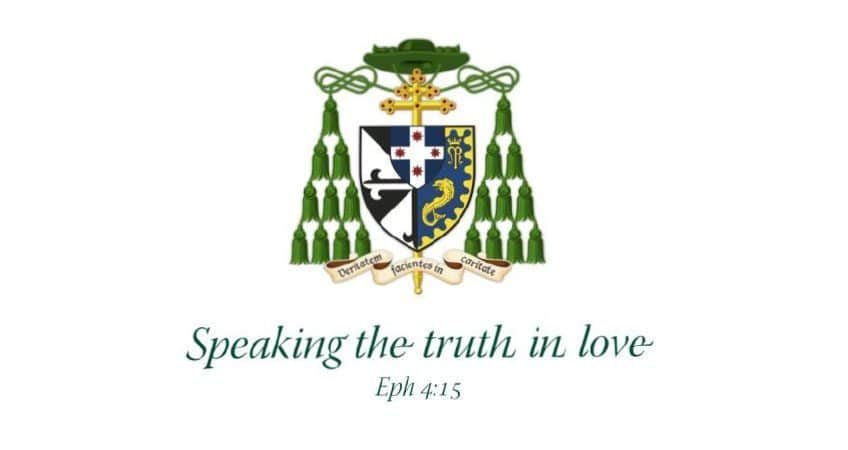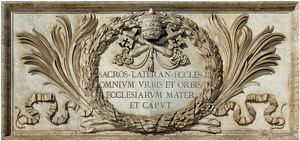Homily on the Feast of the Dedication of the Lateran Basilica Redemptoris Mater Seminary, Chester Hill

Homily on the Feast of the Dedication of the Lateran Basilica
Redemptoris Mater Seminary, Chester Hill, 9 November 2015
The Medieval Florentine poet, Dante Alighieri, authored the most famous poem in the history of Christendom, The Divine Comedy. When one of my Aussie-born seminarians in Parramatta asked me if he could study mediæval Italian so he could read the Divina Commedia in the original I was delighted and said go right ahead: I presume all the Italian speaking seminarians here have done likewise. Dante’s classic describes his journeys through the torments of the Inferno, the purifying pains of the Purgatorio and the beatitude of the Paradiso. In Canto XXXI of Il Paradiso, Dante compares his reaction at being transported mystically to the spiritual realms with the barbarians who were agog when they saw the Eternal City of Rome. Many a time I’ve been equally awestruck by the beauty and history of that city of Romulus and Remus, the Tyrants and the Emperors, the Senate and the Populace, Peter and Paul, the Farnese and Vittorio Emanuele… In that great city there are not one but four patriarchal churches, the ‘archbasilicas’ of the popes, each magnificent in its scale, history, architecture and art.
Dante says it was ‘the Lateran’ above all that dumbfounded the barbarians. Here he is not referring to the ancient Laterani family, then long forgotten, or to the Lateran Treaty between Vatican City State and the Italian Republic, then long in the future, but to a precinct on the Cælian Hill, about a mile from the Colosseum. Here we encounter today one of the oldest baptisteries in all of Christendom, a thriving seminary and important Catholic university, an apostolic palace which has had many uses over the centuries and the holy stairs brought by St Helena from Pilate’s Palace in Jerusalem. But what we celebrate in the Liturgy today is the church on that site. Contrary to the popular misconception that St Peter’s is the Cathedral Church of Rome, this church of St John at the Lateran is the seat of the Bishop of Rome, Vicar of Jesus Christ, and Servant of the Servants of God.

Today all over the world we celebrate the Dedication of that church. Why? – we might wonder. One key is on its façade: the words Sacrosancta Lateran/ensis ecclesia omnium urbis et orbis ecclesiarum mater et caput – the Most Holy Lateran Church, mother and the head of all the churches in the city and the world. So the building itself makes an ecclesiological point: that we are one Church throughout the world, in which the same faith is proclaimed and the same Eucharist offered, one church united by having the Church of Rome and especially the Bishop of Rome to lead and parent it.
Lucius Sextius Lateranus was the first plebeian to become consul of Rome and that set his family up both for fame and for envy. Four centuries later one of his descendants, Plautius Lateranus was also consul when Nero accused him of conspiring against the emperor and confiscated all his property. In due course it fell into the hands of Constantine who in 311 gave it to the Church. Pope Sylvester I dedicated the basilica on this day in 324 and it became the church of the popes and the palace next door their residence. Later it would host five ecumenical councils between 1123 and 1517. It had and still has the look of an ancient Rome ‘basilica’ or hall for public meetings: it’s a great barn of a building, with a wide nave and two side aisles. This too makes a theological point: that if our Church is not of this world still it is in this world; it must be a meeting place of human beings and a bridge between them and the spiritual world; and it must aspire to be that for all peoples, and so be a capacious, generous, expansive, arms-wide-open sort of Church.
Now, anything that old and important will have been subject to the vicissitudes of time and place. Originally St Saviour’s, it somehow got connected with John the Baptist and John the Evangelist. Originally a splendid structure of wood, marble and lots of gold, it was repeatedly looted by the Vandals and rebuilt by the Christians. In the ninth century it was ruined by earthquake and again rebuilt; in Dante’s time it was burnt down and rebuilt once more. The popes from the Renaissance onwards came to prefer St Peter’s to St John’s but with its 18th century façade it remains to this day the mother church of Rome and the world. This too is instructive: our Church transcends space and time, but lives in space and time; it is in the same ‘space’ theologically, teaching the same revealed truths, and yet evolves, so that its doctrine and practice develop over time.
It’s interesting that Dante compares the awe he felt when encountering the realm of eternity to the dumbfoundedness of the barbarians when seeing something like St John’s. Even they, it seems, grasped that here there was not just something big and rich in a worldly sense, but something bigger and richer than anything in our earthly experience. The reason churches like St John’s are consecrated is to point to that eternity which they promise. From the humblest country chapel to the grandeur of San Giovanni in Laterano, Catholic churches are the site where the temporal meets the eternal, the human the divine, where the Sacrifice of the Mass is offered on the altar of that church, the altar of the world, the altar of Christ’s cross. In Ezekiel’s vision life-giving water flows abundantly from the Temple (Ez 47:1-2, 8-9, 12), a premonition of the sacramental life that begins in Holy Baptism and which has as it source the blood and water flowing from the side of Jesus Christ, the true Temple (Jn 2:13-22, 19:34). It was this body that was raised to glory on the third day after its destruction, just as the Church, His body on earth, symbolized by the Lateran, has been rebuilt many times.
It is my joy to celebrate Mass for you today, my sons in formation not in the Roman Seminary at the Lateran but in the Redemptoris Mater one in Sydney. God-willing, through the formation you receive here and in the Neocatechumenal Way, you will progress in faith and virtue and pastoral zeal so that you will one day soon be ready to be ordained as priests of Jesus Christ. We witnessed this for three of your brothers recently: at the time I said it should be light at the end of the tunnel for you all. From all over the world, you are charged with being missionaries to secular Sydney and beyond, proclaiming the first kerygma and a new evangelisation. You are called to build up the Body of Christ, mediating the divine life shared with us as the fruit of the ‘destruction’ of the Temple that is Christ on the Cross. I pray that you use this time of formation well and learn to love the Body of Christ that is the Eucharist and the Church. May God bless you!

